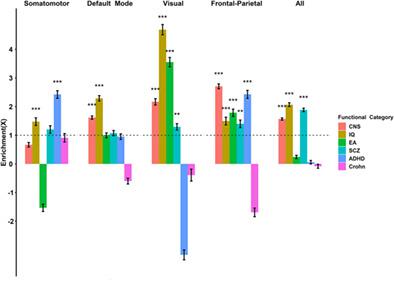当前位置:
X-MOL 学术
›
Hum. Brain Mapp.
›
论文详情
Our official English website, www.x-mol.net, welcomes your
feedback! (Note: you will need to create a separate account there.)
Partitioning heritability analyses unveil the genetic architecture of human brain multidimensional functional connectivity patterns.
Human Brain Mapping ( IF 3.5 ) Pub Date : 2020-04-24 , DOI: 10.1002/hbm.25018 Junjiao Feng 1 , Chunhui Chen 1 , Ying Cai 2 , Zhifang Ye 1 , Kanyin Feng 1 , Jing Liu 1 , Liang Zhang 1 , Qinghao Yang 1 , Anqi Li 1 , Jintao Sheng 1 , Bi Zhu 1 , Zhaoxia Yu 3 , Chuansheng Chen 4 , Qi Dong 1 , Gui Xue 1
Human Brain Mapping ( IF 3.5 ) Pub Date : 2020-04-24 , DOI: 10.1002/hbm.25018 Junjiao Feng 1 , Chunhui Chen 1 , Ying Cai 2 , Zhifang Ye 1 , Kanyin Feng 1 , Jing Liu 1 , Liang Zhang 1 , Qinghao Yang 1 , Anqi Li 1 , Jintao Sheng 1 , Bi Zhu 1 , Zhaoxia Yu 3 , Chuansheng Chen 4 , Qi Dong 1 , Gui Xue 1
Affiliation

|
Resting‐state functional connectivity profiles have been increasingly shown to be important endophenotypes that are tightly linked to human cognitive functions and psychiatric diseases, yet the genetic architecture of this multidimensional trait is barely understood. Using a unique sample of 1,704 unrelated, young and healthy Chinese Han individuals, we revealed a significant heritability of functional connectivity patterns in the whole brain and several subnetworks. We further proposed a partitioned heritability analysis for multidimensional functional connectivity patterns, which revealed the common and unique enrichment patterns of the genetic contributions to brain connectivity patterns for several gene sets linked to brain functions, including the genes expressed preferentially in the central nervous system and those associated with intelligence, educational attainment, attention‐deficit/hyperactivity disorder, and schizophrenia. These results for the first time reveal the genetic architecture of multidimensional brain connectivity patterns across different networks and advance our understanding of the complex relationship between gene sets, neural networks, and behaviors.
更新日期:2020-04-24











































 京公网安备 11010802027423号
京公网安备 11010802027423号